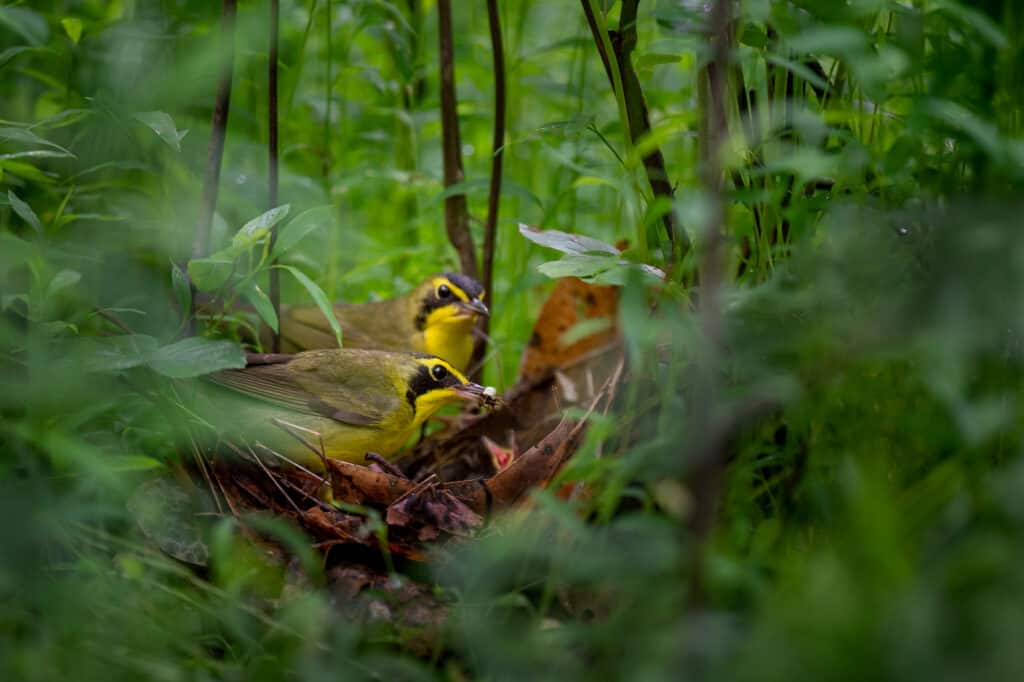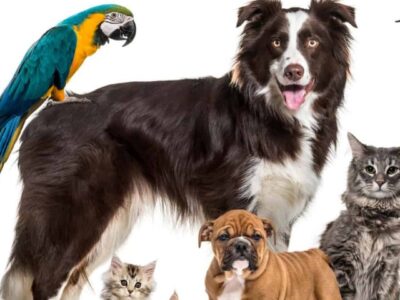Kentucky Warbler
Geothlypis formosa
The Kentucky Warbler appears to wear bright yellow cat-eye glasses!
Advertisement
Kentucky Warbler Scientific Classification
- Kingdom
- Animalia
- Phylum
- Chordata
- Class
- Aves
- Order
- Passeriformes
- Family
- Parulidae
- Genus
- Geothlypis
- Scientific Name
- Geothlypis formosa
Read our Complete Guide to Classification of Animals.
Kentucky Warbler Conservation Status
Kentucky Warbler Facts
- Prey
- Insects, spiders, invertebrates, larvae
- Main Prey
- Insects
- Name Of Young
- Chicks
- Group Behavior
- Pair
- Fun Fact
- The Kentucky Warbler appears to wear bright yellow cat-eye glasses!
- Estimated Population Size
- 2,600,000 mature individuals
- Biggest Threat
- Habitat degradation
- Most Distinctive Feature
- Bright yellow spectacles
- Distinctive Feature
- Olive plumage on upper parts; bright yellow plumage underneath; black cap and neck on males; dark cap and neck, but not black, on females
- Temperament
- Territorial
- Wingspan
- 7.9 to 8.7 inches
- Incubation Period
- 12 to 13 days
- Age Of Fledgling
- 8 to 10 days
- Habitat
- Deciduous forest with dense undergrowth
- Predators
- Snakes
- Diet
- Omnivore
- Lifestyle
- Diurnal
- Pair
- Favorite Food
- Insects
- Special Features
- Bright yellow spectacles; black cap on males; olive plumage on upper parts; bright yellow plumage below; long, pointed bill
- Number Of Species
- 1
- Average Clutch Size
- 4
- Nesting Location
- On the ground, usually near a bush or plant that provides cover
- Migratory
- 1
Kentucky Warbler Physical Characteristics
- Color
- Yellow
- Black
- Olive
- Skin Type
- Feathers
- Lifespan
- 6.5 to 8 years
- Weight
- 0.5 ounces
- Length
- 5.1 to 5.25 inches
- Age of Sexual Maturity
- 1 year
- Venomous
- No
- Aggression
- Medium
View all of the Kentucky Warbler images!
The Kentucky Warbler appears to wear bright yellow cat-eye glasses!
The Kentucky Warbler is a member of the Parulidae family of New World or wood warblers. It lives primarily in the eastern United States, from Nebraska to New York and south to the Gulf of Mexico, as well as parts of Mexico, Central America and the Caribbean. This little olive bird with the bright yellow spectacles, black cap, and stunning yellow breast is good at hiding. It spends most of its time on the forest floor foraging for food. But it is also fiercely territorial, and it will chase any rivals away from its nest. The males sing their two-note song persistently, especially during breeding season. You’re more likely to hear them than you are to see them.
Incredible Kentucky Warbler Facts
- Kentucky Warblers wear black or dark-colored caps and have bright yellow spectacles.
- These birds spend most of their time on the ground.
- A Scottish naturalist first described these birds in 1811, two years before he died.
- Due to their aggressive nature, these small birds require a large territory for breeding.
- Kentucky Warblers follow army ants and snatch the critters that are running for safety.
- This species was only recently moved to the Geothlypis genus. Many resources still have it listed under Oporornis.
- Another common name for this bird is the Kentucky Wagtail.
Where to Find the Kentucky Warbler
The Kentucky Warbler is found throughout much of the eastern United States, from the eastern edges of Texas, Oklahoma, Kansas, and Nebraska all the way to the coast. The breeding range in the United States extends north into Wisconsin, east to New York, and stretches down to the panhandle of Florida. This warbler also has breeding territory in Mexico, Guatemala, Honduras and Nicaragua. Migration routes and winter grounds include much of Central America, the Caribbean and northern South America.
Within the United States, the Kentucky Warbler prefers deciduous forests with dense undergrowth and access to water. They spend most of their time on the ground or close to it, and they require a large amount of mostly uninterrupted territory for breeding. In their winter grounds, they tend to frequent plantations or tropical forests.
Kentucky Warbler Nests
These birds make their nests on the ground, usually at the base of a shrub, fern or bramble that will provide some cover. Sometimes the female chooses to place the nest a bit higher, within a shrub or bush. Ground nests are placed on fallen leaves and built in a cup shape from rootlets and grasses. The bird may, on occasion, even incorporate live plants in the design, bending them and fashioning a roof or overhang for added shelter.
Scientific Name
The scientific name of the Kentucky Warbler is Geothlypis Formosa but until very recently it was known as Oporornis formosus. It was reassigned to the Geothlypis genus along with two other warblers. Geothlypis is a word derived from Greek roots meaning, basically, ground bird. It is the name of the genus within the Parulidae family of wood warblers that contains yellowthroats. Formosa is derived from Latin, meaning beautiful.
The Kentucky Warbler was first described by Alexander Wilson, a Scottish naturalist, in 1811. He named the bird, also later known as the Kentucky Wagtail, for the state in which it was found. Sadly, Wilson died from dysentery at the age of 47 just two years later.
There are currently two recognized subspecies of the Kentucky Warbler. The nominal subspecies, G. formosa formosa, and a second subspecies, G. formosa umbratica, identified in 1974.
Appearance
Kentucky Warblers are small, brightly colored birds, a bit larger than the Common Yellowthroat of the same genus. They are about the same size as a small sparrow, weighing only about 0.5 ounces, or 13 to 14 grams. They are approximately 5.1 to 5.25 inches long. Their wingspan ranges from 7.9 to 8.7 inches.
The most distinctive feature of the Kentucky Warbler is the pair of bright yellow spectacles it wears. This thin line of feathers goes from the bill over each black eye and around the side, not quite enclosing the entire eye in a circle. Their bill is long and pointed, and useful for plucking prey from the leaf litter on the forest floor.
This bird has olive plumage on its upper parts and bright yellow feathers underneath, from its chin to its tail. Its tail is relatively short and often held upright in the manner of a warbler. It has pinkish legs and feet.

A pair of Kentucky Warblers feed their chicks in the nest.
©Ray Hennessy/Shutterstock.com
The males and females of this species look very similar, although some sexual dimorphism is displayed. Males have a black cap on their crown. They also have a black face mask, running across their eyes and down the sides of their neck. Females also have these markings, but they are not black. They are dark olive gray instead. Juveniles have just a hint of the dark markings they will soon wear, or depending on their age, none at all.
Behavior
Kentucky Warblers spend the majority of their lives on or near the forest floor. They live and make their nests on the ground, in areas of dense cover. Whether to conserve energy or to avoid predators, they prefer to walk around gracefully, foraging for food in the leaf litter rather than flying after a meal.
They will, however, willingly expend their energy defending their territory against rivals.
These spectacled birds are highly territorial, and once the males have staked out a piece of the forest to call their own, they will fight to keep it. They use threatening displays, like raising their black caps and vocalizing, and if that doesn’t work, they will take to the air and chase interlopers away.
Kentucky Warblers are often more easily heard than seen. They have a simple and repetitive two-note song that starts low and goes higher. It is described a number of ways by birders, with no true consensus on the syllables, so please take this description of “tchur-ry, tchur-ry, tchur-ry, tchur-ry” as you will. Most agree the song is similar to that of a Carolina Wren or a Northern Cardinal.
Diet
Kentucky Warblers are mainly insectivores, although they do occasionally eat some fruits and berries. Their diet consists primarily of insects, larvae, spiders and other invertebrates they can find on the ground. They use their bills to sift through leaf litter and forage for food. They also make quick flights, hawking insects and other prey from the surfaces of plants, as well as in the air.
The Kentucky Warbler is among several migratory species that are known to have a peculiar relationship with army ants. They monitor the movements of the army ants, and when they see them on the march, they pounce. But they don’t just gobble up the ants. Instead, they eat up all the little creatures that run for their lives ahead of the swarm.
Kentucky Warbler Reproduction
Kentucky Warblers return from their winter migration just about the time they reach sexual maturity. The birds form somewhat monogamous pairs, but as seen in similar species, female Kentucky Warblers often engage in extrapair mating with other males. Research shows males with a darker black cap and neck are more likely to be selected for mating.
Kentucky Warblers build their cup-shaped nests on a patch of fallen leaves on the ground, usually close to the base of a plant or shrub that will provide cover. They sometimes build a little off the ground in dense vegetation. They make the nests from grass and rootlets with softer materials on the inside. Then they lay an average of three to six eggs and usually have just one or two broods per year. The female incubates the eggs for 12 to 13 days, during which time the male guards the territory, but only occasionally delivers food. Chicks fledge after 8 to 10 days and may be fed by both parents for two or more weeks after that.
Predators
As forest dwellers, Kentucky Warblers are vulnerable to birds of prey such as owls, hawks, and especially domestic cats. Nest predators may also include snakes and small mammals such as squirrels and chipmunks. Larger forest dwellers such as foxes, skunks, and raccoons are likely predators, as are opportunistic birds like crows.
Lifespan of the Kentucky Warbler
The Kentucky Warbler lives about 6.5 years in the wild. The oldest recorded individual was a banded bird that lived to be least 8 years. With a population of approximately 2.6 million mature individuals, the species is considered a species of least concern by the IUCN Red List of Threatened Species. But their numbers are decreasing. Habitat fragmentation due to changes in land use and degradation due to deer overpopulation are among the main threats. Nest parasitism by the Brown-headed Cowbird, along with predation, especially by feral cats, are also concerns.
Similar Animals
- Ovenbird – This member of the Parulidae family also spends most of its time on the ground.
- Canada Warbler – This warbler with a black bib migrates over 3,000 miles from Canada to South America.
- Orange-Crowned Warbler – This warbler is may seem rather nondescript except for its orange crown, but with a population of more than 76 million, it’s worth a second look.
Kentucky Warbler FAQs (Frequently Asked Questions)
What does the Kentucky Warbler look like?
The male Kentucky Warbler has a black cap and yellow spectacles that resemble retro cat-eye glasses. The sides of his face and neck are black, as are his eyes and his long, pointed black bill. His upper parts are olive, and his under parts from his chin to his tail are bright, lemon yellow. He has pinkish legs and feet. Females are nearly identical, except that their cap and the sides of their face are not black, but darker than the rest of their olive plumage.
How big is the Kentucky Warbler?
The Kentucky Warbler is slightly larger than the Common Yellowthroat and about the size of a small sparrow. It averages between 5.1 and 5.25 inches in length and weighs only 0.5 ounces.
What is the Kentucky Warbler’s wingspan?
The wingspan of the Kentucky Warbler is between 7.9 and 8.7 inches.
How fast do Kentucky Warblers fly?
Even though Kentucky Warblers spend most of their time on or very near the ground, they can fly fast. They spend a significant amount of time in the air, chasing one another as they defend their territories aggressively.
How many varieties of Kentucky Warblers exist?
According to the Integrated Taxonomic Information System, there are currently only two subspecies of Kentucky Warbler. The first was described in 1811 by a Scottish naturalist named Alexander Wilson who gave the species its common name after the state in which it was found. The second subspecies was described in 1974.
What makes the Kentucky Warbler special?
The Kentucky Warbler’s distinct facial pattern makes it easier than many of the yellowthroats to identify. Those bright yellow spectacles are difficult to miss.
Where do Kentucky Warblers live?
The breeding range for the Kentucky Warbler includes most of the eastern portion of the United States, from Nebraska to New York and south to the Gulf of Mexico. It is also found in much of Mexico, the Caribbean and in Central America and far northern South America.
Do Kentucky Warblers migrate?
Most Kentucky Warblers do migrate, with some traveling very long distances. Some members of the species stay in the same area year-round. The fall migration begins in late September through October, and the birds return north in the spring from late March through April.
What do Kentucky Warblers eat?
Kentucky Warblers are mainly insectivores. They eat insects, larvae, spiders and other invertebrates that they find in the leaf litter on the forest floor. They also catch prey on plant surfaces as well as sometimes flying insects. These warblers also eat berries and fruit occasionally.
How do Kentucky Warblers choose a mate?
One way that female Kentucky Warblers choose their mate is based on the intensity of the black and bright yellow color ornamentation, which can indicate the male’s health.
Are Kentucky Warblers monogamous?
Kentucky Warblers form socially monogamous pairs, but they also engage in extrapair mating with others outside their pair bond.
Where do Kentucky Warblers nest?
Kentucky Warblers nest on the floor of deciduous forests where dense vegetation is abundant and preferably near a stream or other source of fresh water. They build their nests on the ground on top of a pile of fallen leaves. They usually place the nest near the base of a large plant or shrub so that they are provided some cover. Sometimes they will even incorporate live plants, bending them into a roof of sorts.
How many eggs does the Kentucky Warbler lay?
Kentucky Warblers lay between 3 to 6 eggs per brood. They average approximately 4.5 eggs per brood, and they have 1 to 2 broods each year.
When do Kentucky Warblers leave the nest?
The incubation period for Kentucky Warblers is 12 to 13 days, and chicks fledge after 8 to 10 more days. However, the parents will continue to care for them and feed them outside the nest for at least a couple of weeks after the chicks fledge.
How long do Kentucky Warblers live?
The average lifespan of a Kentucky Warbler is about 6.5 years. The longest living individual on record was a banded bird that lived at least 8 years.
Are Kentucky Warblers rare?
Kentucky Warblers are not rare. Their population is estimated at 2.6 million mature individuals, but that number is declining. Their range extends from the United States to northern South America, and they are listed as a species of least concern on the IUCN Red List of Threatened Species.
Thank you for reading! Have some feedback for us? Contact the AZ Animals editorial team.
Sources
- Bill Chaisson, Available here: https://www.eagletimes.com/lifestyles/of-a-feather-who-is-that-masked-warbler/article_e7a2d9ed-fa66-525c-8d18-342f58ce67b9.html
- Bob Roseth, Available here: https://www.washington.edu/news/2010/08/30/army-ant-raids-help-birds-survive-the-winter-in-costa-rica/
- Timothy H. Parker, et al., Available here: https://www.jstor.org/stable/1370571
- IUCN Red List of Threatened Species, Available here: https://www.iucnredlist.org/species/22721812/137319618#assessment-information

















